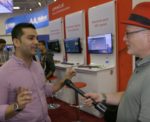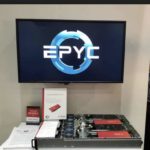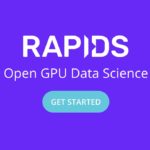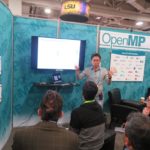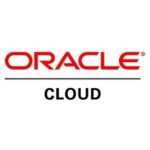In this video from SC18, Karan Batta from Oracle describes how the company provides high performance computing in the Cloud with Bare Metal speed. “Oracle Bare Metal Cloud Services (BMCS) public cloud infrastructure. Oracle BMCS is a new generation of scalable, inexpensive and performant compute, network and storage infrastructure that combines internet cloud scale architecture with enterprise scale-up bare metal capabilities, providing the ideal platform for demanding High Performance Computing workloads.”
AMD EPYC Processors come to Oracle Cloud Infrastructure for HPC
AMD has announced the availability of the first AMD EPYC processor-based instance on Oracle Cloud Infrastructure. “The AMD EPYC processor ‘E’ series will lead with the bare metal, Standard ‘E2’, available immediately as the first instance type within the Series. At $0.03/Core hour, the AMD EPYC instance is up to 66 per cent less on average per core than general purpose instances offered by the competition.”
Open Source RAPIDS GPU Platform to Accelerate Predictive Data Analytics
Today NVIDIA announced a GPU-acceleration platform for data science and machine learning, with broad adoption from industry leaders, that enables even the largest companies to analyze massive amounts of data and make accurate business predictions at unprecedented speed. “It integrates seamlessly into the world’s most popular data science libraries and workflows to speed up machine learning. We are turbocharging machine learning like we have done with deep learning,” he said.
Celebrating 20 Years of the OpenMP API
“The first version of the OpenMP application programming interface (API) was published in October 1997. In the 20 years since then, the OpenMP API and the slightly older MPI have become the two stable programming models that high-performance parallel codes rely on. MPI handles the message passing aspects and allows code to scale out to significant numbers of nodes, while the OpenMP API allows programmers to write portable code to exploit the multiple cores and accelerators in modern machines.”
Radio Free HPC looks at New Leadership at HPE
In this podcast, the Radio Free HPC team looks at HPE’s new CEO, Antonio Neri, a longtime HPE executive who previously served as President of the company. As the number 1 server vendor in the HPC space, this change will be one to watch as we transition to the exascale era in the next five years or so. “This transistion comes at an interesting time for HPE, as one of their main competitors, Dell Technologies, is reportedly looking at an IPO or reverse acquisition by VMware.”
Job of the Week: Cloud Performance Architect at Oracle in Seattle
Oracle in Seattle is seeking a Cloud Performance Architect in our Job of the Week. “As a Cloud Performance Architect, you will be a leading contributor in improving performance of Oracle’s latest Cloud Services Technologies. You will take an active role in the definition and evolution of standard practices and procedures. Additionally, you will be responsible for defining and developing software for tasks associated with the developing, designing and debugging of software applications or operating systems. If you have a passion for improving and creating high performance software products, this is the place where you can make a difference.”
Radio Free HPC Reviews the SC16 Student Cluster Competition Configurations & Results
In this podcast, the Radio Free HPC team reviews the results from SC16 Student Cluster Competition. “This year, the advent of clusters with the new Nvidia Tesla P100 GPUs made a huge impact, nearly tripling the Linpack record for the competition. For the first-time ever, the team that won top honors also won the award for achieving highest performance for the Linpack benchmark application. The team “SwanGeese” is from the University of Science and Technology of China. In traditional Chinese culture, the rare Swan Goose stands for teamwork, perseverance and bravery.”
Video: Software-Defined Networking on InfiniBand Fabrics
A design for virtual Ethernet networks over IB is described. The virtual Ethernet networks are implemented as overlays on the IB network. They are managed in a flexible manner using software. Virtual networks can be created, removed, and assigned to servers dynamically using this software. A virtual network can exist entirely on the IB fabric, or it can have an uplink connecting it to physical Ethernet using a gateway. The virtual networks are represented on the servers by virtual network interfaces which can be used with para-virtualized I/O, SRIOV,and non-virtualized I/O. This technology has many uses: communication between applications which are not IB-aware, communication between IB-connected servers and Ethernet-connected servers, and multi-tenancy for cloud environments. It can be used in conjunction with OpenStack, such as for tenant networks.”
Dispelling the Myth “OpenMP Does Not Scale”
Ruud van der Pas from Oracle presented this talk at OpenMPcon. “Unfortunately it is a very widespread myth that OpenMP Does Not Scale – a myth we intend to dispel in this talk. Every parallel system has its strengths and weaknesses. This is true for clustered systems, but also for shared memory parallel computers. While nobody in their right mind would consider sending one zillion single byte messages to a single node in a cluster, people do the equivalent in OpenMP and then blame the programming model. Also, shared memory parallel systems have some specific features that one needs to be aware of. Few do though. In this talk we use real-life case studies based on actual applications to show why an application did not scale and what was done to change this. More often than not, a relatively simple modification, or even a system level setting, makes all the difference.”

